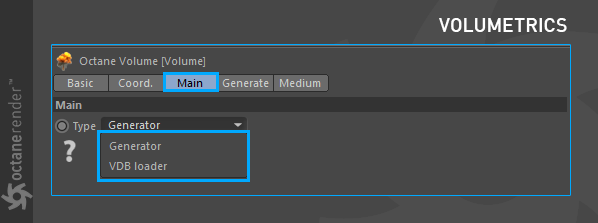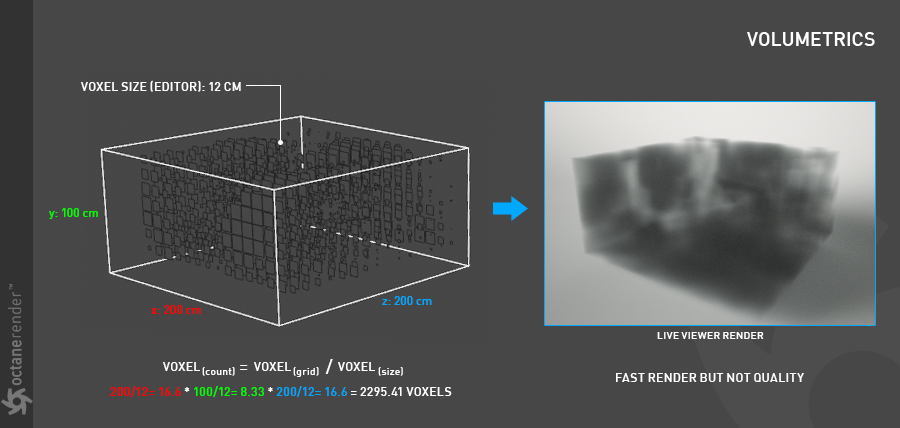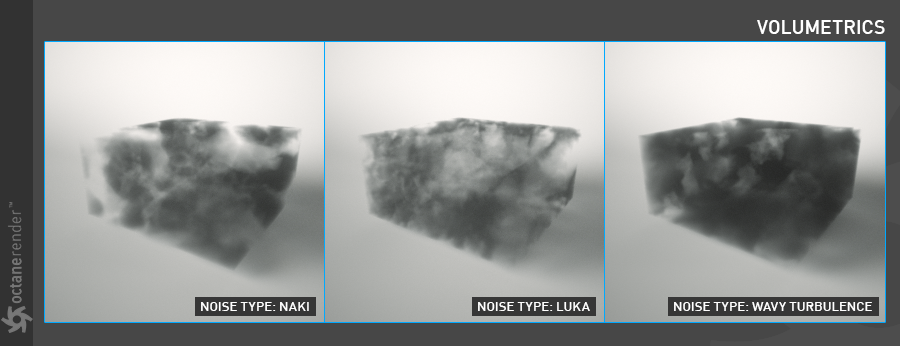GENERATE
When you go to the Main Tab, you will have 2 options in the type section: "Generator" and "VDB Loader". The generator allows you to create a Voxel grid value from a parametric texture input. From here you can produce volumetric effects as you like.
生成
转到“主要”选项卡时,类型部分中将有2个选项:“ Generator”和“ VDB Loader”。 生成器允许您从参数纹理输入中创建Voxel网格值。 在这里,您可以根据需要产生体积效果。

Now let's move on through a small example to show the options here. First, select Generator from the main tab then go to the "Generate" tab.
现在,让我们继续通过一个小示例在此处显示选项。 首先,从主选项卡中选择Generator,然后转到“ Generate”选项卡。

Press "Cloud 1" from the Preset buttons on the top right of the Generate Tab. When you press it, the voxel in the viewport will change, and Cinema 4d Noise will be added to the texture slot. This noise type is now the data in the Voxel grid, and each Voxel has the value of this noise type. So, you have made 3D voxel data from 2D procedural data. If you wish, you can change this noise type from the texture settings and produce quite different volumetric effects. The noise in the texture is the "Naki" from Cinema 4D noise. In order to give this voxel data true volumetric properties, you have to make a lot of adjustments in the Volume Medium section. We'll explain these in the Volume Effects section.
Important note: Do not use Octane textures (eg Octane noise, turbulence) when defining texture because all texture types are "Gpu Shader" in Octane. Voxels only work in "Cpu Shaders" at the moment. Cinema 4D Noise is a Cpu shader.
从“生成”选项卡右上方的“预设”按钮中按“云1”。 按下它时,视口中的体素将更改,并且Cinema 4d Noise将添加到纹理插槽。 现在,此噪波类型是Voxel网格中的数据,每个Voxel都有该噪波类型的值。 因此,您已经从2D程序数据中获得了3D体素数据。 如果需要,可以从纹理设置更改此噪波类型,并产生完全不同的体积效果。 纹理中的噪点是Cinema 4D噪点中的“ Naki”。 为了使该体素数据具有真实的体积特性,您必须在“体积介质”部分中进行大量调整。 我们将在“音量效果”部分中进行解释。
重要说明:定义纹理时请勿使用Octane纹理(例如,Octane噪波,湍流),因为所有纹理类型均为Octane中的``Gpu着色器''。 目前,体素仅在“ Cpu着色器”中工作。 Cinema 4D Noise是一个Cpu着色器。

GENERATor SETTINGS
生成设置
preset buttons
With these buttons you can quickly create Voxel data. Default is to return to the initial state. The Cloud 1 button creates the Cinema 4d "Naki" noise on the texture channel. Each time you press the Random Cloud button, the noise type in the texture section changes to random.
预设按钮
使用这些按钮,您可以快速创建Voxel数据。 默认为返回初始状态。 “云1”按钮在纹理通道上创建Cinema 4d“ Naki”噪波。 每次按“随机云”按钮,纹理部分中的噪波类型都会更改为随机。
SIZE & Voxel SIZE (EDITOR)
These 2 options work together. Here you can set the Voxel size and number. The most important issue when working with voxel based is to make the right settings for voxel grid and voxel size. Because both GPU power and VRAM are used extensively and render times are quite high. So you have to make these settings exactly according to your purpose. You can use the following formula when making both adjustments:
尺寸和体素尺寸(编辑)
这两个选项一起工作。 在这里您可以设置体素的大小和数量。 使用基于体素的最重要的问题是对体素网格和体素大小进行正确的设置。 因为GPU功能和VRAM都被广泛使用,并且渲染时间非常长。 因此,您必须完全根据自己的目的进行这些设置。 进行两项调整时,可以使用以下公式:

For example, if you set your Voxel grid size to x200 cm / y100 cm / z200 cm and voxel size to 12 cm, the number of voxels you will get is 2294.41 according to this formula. In this voxel resolution, rendering may not be very good quality, but it will be quite fast. You can see the details in the picture below.
例如,如果将体素网格尺寸设置为x200 cm / y100 cm / z200 cm并将体素尺寸设置为12 cm,则根据此公式,将获得的体素数量为2294.41。 在这种体素分辨率下,渲染可能不是很好的质量,但是会很快。 您可以在下图中看到详细信息。

Now if you keep the Voxel grid size the same but if you make voxel size 4 cm, the number of voxels will be 62,500 according to the same formula. At such a voxel resolution, the use of GPU power and Vram will increase and render will slow down. The render is slower, especially when you use the Volume medium. But the quality will be good. Here you can decide how to create a volumetric effect using this formula and how it will look. Remember, do not change suddenly these values when entering them. Go in small steps. For example, if you bring Voxel size closer to zero, you'll probably crash the plugin. So be careful and enter the exact values you need.
现在,如果保持体素栅格大小不变,但是如果将体素大小设为4 cm,则根据相同公式,体素的数量将为62,500。 在这样的体素分辨率下,GPU功率和Vram的使用将增加,渲染速度将降低。 渲染速度较慢,尤其是在使用“体积”介质时。 但是质量会很好。 在这里,您可以决定如何使用此公式创建体积效果以及外观。 请记住,输入这些值时不要突然更改它们。 一步步走。 例如,如果将Voxel大小缩小为零,则可能会使插件崩溃。 因此,请小心并输入所需的确切值。

Voxel mult. (render)
This option is important for Picture Viewer (PV) rendering quality. While using this option, you can also refer to the following formula:
体素多。 (渲染)
此选项对于Picture Viewer(PV)渲染质量很重要。 使用此选项时,您还可以参考以下公式:

Let's say the voxel size on your scene is 10 cm. According to this formula, If you make Voxel Multiplier 2, the resulting Voxel size will be 10/2 = 5 cm and the number of Voxel in PV will be 2 * 2 * 2 = 8 times more than the number of Voxel in LV. In this case Vram and Gpu power will calculate 8 times more. If you do Voxel Mult. 8 in the same way, this time Voxel will be 10/8 = 1.25 and the number of Voxel in PV will be 8 * 8 * 8 = 512 times more than the number of Voxel in LV. This number means 512 times more calculations. So be careful when making this adjustment. You can force the Vram limits and crash the Plugin.
If you do not want to get involved with this setting and you are happy with the result in LV, leave it to 1.
假设您场景中的体素大小为10厘米。 根据此公式,如果制作Voxel乘数2,则生成的Voxel大小将为10/2 = 5 cm,PV中的Voxel数量将是LV中的Voxel数量的2 * 2 * 2 = 8倍。 在这种情况下,Vram和Gpu的功效将增加8倍。 如果您执行Voxel Mult。 以同样的方式将8设为像素,此时Voxel将为10/8 = 1.25,PV中的Voxel数量将是LV中的Voxel数量的8 * 8 * 8 = 512倍。 此数字意味着要多进行512次计算。 因此,进行此调整时要小心。 您可以强制Vram限制并使插件崩溃。
如果您不想参与此设置,并且对LV中的结果感到满意,请将其设置为1。

EDge feather
It is used to give feather to the edges of Grid and Voxel. So you can get a smooth volume.
边缘羽化
用于为网格和体素的边缘赋予羽毛。 这样您就可以获得一个平滑的音量。

texture
You can define the textures (greyscale) here for Voxels. As we said before, do not use octane textures, which are GPU shaders, it will not work. Cinema 4D's CPU shaders will run like Noise, Gradient etc. Most scenarios work very well because Cinema's Noise is very detailed and gives you a lot of control.
纹理
您可以在此处为体素定义纹理(灰度)。 如前所述,请勿使用Octane纹理(GPU着色器),它将无法正常工作。 Cinema 4D的CPU着色器将像“噪波”,“渐变”等一样运行。大多数情况下都可以很好地工作,因为Cinema's Noise非常详细,可以为您提供很多控制。

dIsplay type
Here you can set the voxels appear in the viewport.
显示类型
在这里您可以设置体素出现在视口中。











赶快留个言打破零评论!~